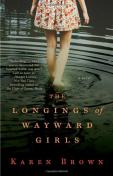BKMT READING GUIDES
The Longings of Wayward Girls: A Novel
by Karen Brown
Paperback : 336 pages
6 clubs reading this now
1 member has read this book
Introduction
It’s an idyllic New England summer, and Sadie is a precocious only child on the edge of adolescence. It seems like July and August will pass lazily by, just as they have every year before. But one day, Sadie and her best friend play a seemingly harmless prank on a neighborhood girl. Soon after, that same little girl disappears from a backyard barbecue—and she is never seen again. Twenty years pass, and Sadie is still living in the same quiet suburb. She’s married to a good man, has two beautiful children, and seems to have put her past behind her. But when a boy from her old neighborhood returns to town, the nightmares of that summer will begin to resurface, and its unsolved mysteries will finally become clear.
Discussion Questions
1. Read the epigraph of the novel aloud. How does it serve to frame the narrative that follows it?2. Consider the mother-daughter dynamics that are depicted within the novel. How do you think Sadie’s experience of being mothered by Clare impacts how she mothers Sylvia?
3. What do you make of Sadie and Craig’s relationship? Why do you think Sadie is drawn to Ray to begin with, and why does she ultimately return to Craig? Do you believe Ray when he writes to Sadie, “I knew who I had. I knew who you were” (p. 308)?
4. The weight of history—and the sense that it can repeat itself—is felt throughout the novel. As a group, can you brainstorm moments within the novel in which it appears (as Faulkner once famously said that “the past isn’t dead—it isn’t even past”)?
5. Consider the theme of female companionship in the novel. In what ways is it shown to be sustaining—and in what ways can it turn sinister?
6. Both Sadie and Clare are involved with the local theater troupe. What is the difference between this kind of formalized acting and other forms of role-playing that are depicted throughout the novel? Using examples of each, compare and contrast.
7. Turn to the scene on p. 137 in which Kate shows the neighborhood women the Christmas village she has created in her basement. Why do you think Kate has chosen this hobby? What do you make of Sadie imagining Kate returning the next day to her basement, only to discover that “the mothers and fathers and children in her village will have shifted position, moved into other rooms, other houses, stepped out into their snowy yards to stand together without her intervention” (p. 284)?
8. Think about how fate and free will are juxtaposed in the novel. How could the suitcase that Sadie discovers in the old Filley homestead be seen as emblematic of both—or, put differently, as the perfect melding of destiny and agency?
9. What do you make of Beth as a girl—and later, as a grown woman? In what ways can she and Francie be seen as reflections of each other?
10. Consider the domestic spaces that feature prominently in this novel (basements, perhaps) and those that are rarely shown (for example, kitchens). What kinds of activities are the characters engaged in, in each setting? In terms of tone or atmosphere, how are the scenes that take place indoors different than those that transpire outdoors?
11. As a group, reread the scene in which Clare and Patsy run lines from the Tennessee Williams play, The Night of the Iguana. Given what lies ahead for these characters, how do you interpret these lines?
12. While many of the novel’s characters are guilty of various wrongdoings, do you feel that true malice is at the root of any of their crimes? Are there moments when certain individuals could have acted differently to prevent others from getting hurt? Discuss using specific examples from the text.
13. The Longings of Wayward Girls ends with Sadie describing a recurring dream she has about entering her childhood home and wandering the rooms, looking for her mother: “What did she want to tell her? she’d wonder. Now she knows, and finds she has stopped looking” (p. 311). What answers has Sadie come to by the novel’s conclusion? To what extent do you believe she has made peace with her mother’s memory?
14. Though not a ghost story in the classic sense, The Longings of Wayward Girls is filled with ghosts. Who are they, and how does their presence shape the narrative’s development?
Book Club Recommendations
Recommended to book clubs by 1 of 1 members.
Book Club HQ to over 90,000+ book clubs and ready to welcome yours.
Get free weekly updates on top club picks, book giveaways, author events and more








